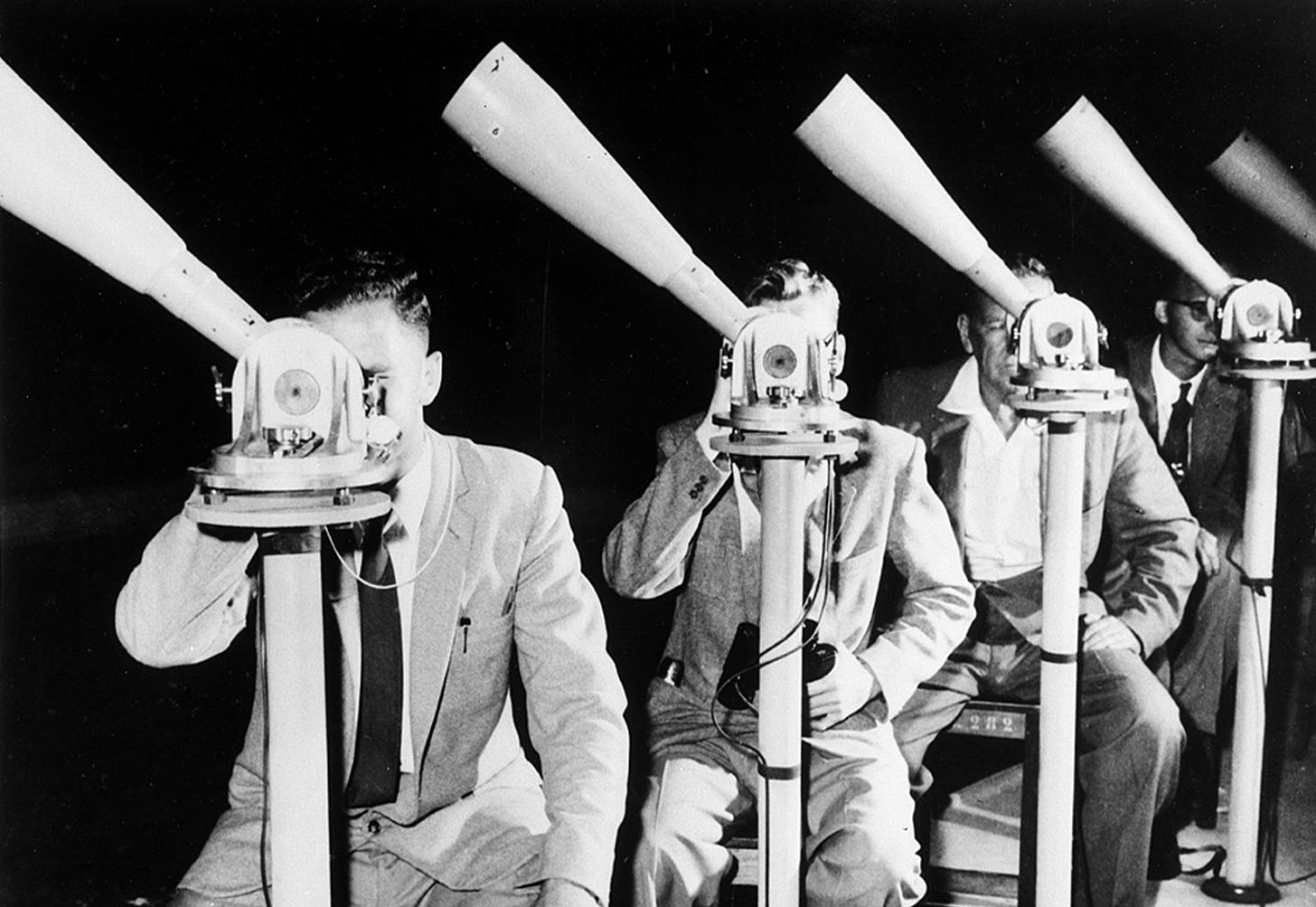We at History, Rinse, & Repeat pride ourselves on finding lesser-known historical events that are comparable to news reported today. The more obscure the historical event, the more self-satisfied we feel. But sometimes, we confess, the analogies are so obvious that they seemingly smack us in the face. One such example is the spate of recent articles regarding the so-called Chinese Spy Balloon. What interests us is not the Balloon itself (balloons have been used for military purposes for over two hundred years, since the wars of the French Revolution), but the political firestorm this simple Balloon has instigated. This firestorm calls to mind another time when a foreign regime launched a device into US airspace for reconnaissance purposes – Sputnik I.
The Soviets Launch Sputnik
Those of a certain generation will recall the effect of the Soviet Union’s announcement that it had launched the first satellite into space, on October 4, 1957, even though, at the time it should have been expected. The concept of a satellite was not particularly novel. In fact, the prospect of a satellite (dubbed little “moon” in contemporaneous accounts) had been the topic of numerous articles in the American press. Just several weeks earlier, the United States had disclosed that it was designing seven different kinds of satellites. At or about the same time, the Soviet Union announced that their own satellite launch was imminent.
Nevertheless, it was widely assumed that the United States would be the first country to put a satellite into space. As a consequence, when the Soviets announced that they had launched their satellite, the nation was stunned, and recriminations followed, directed at the National Advisory Committee for Aeronautics (later NASA) and the United States Naval Research Laboratory, each of which had failed to get a satellite off the launch pad.
The Soviets designed the launch of Sputnik for maximum effect. Although it had contemplated placing a light on the satellite to enable it to be followed by the casual observer, that light was unnecessary. The final satellite was a sphere made of reflective material that reflected the light of the sun so that it could be viewed by anyone through a pair of binoculars. In addition, the Soviets elected to broadcast a radio signal from the satellite at a lower frequency than normal. Although this left the satellite’s broadcast more vulnerable to atmospheric interference, it ensured that amateur ham radio operators could track the flight of the satellite.
The immediate reaction of the public was one of animation. For example, the Museum of Natural History and the Hayden Planetarium reported that they were inundated with telephone calls after the announcement of the launch. Amateur ham radio operators, under the aegis of the American Radio Relay League, joined together to track the satellite’s broadcasts. At the same time, Operation Moonwatch, a loose association of amateur scientists initially created to identify enemy bombers, also played a role in keeping tabs on the Sputnik.
In contrast to that of Sputnik, the launch of the Chinese Spy Balloon was made without any announcement. Nonetheless, it may hardly be doubted that the Chinese intended the effect of its Balloon to be as great on the American public as that of Sputnik. Given the size of the Spy Balloon, and the slow speed at which it was traveling, it was inevitable that it would be spotted by American citizens. It was, in fact, ordinary citizens who were the first to bring the Chinese Spy Balloon to the attention of the American public.
The Reaction to Sputnik
The Eisenhower Administration’s initial public reaction to Sputnik’s launch was one of indifference and calm. President Eisenhower and his advisors tried to downplay the significance of the Soviet’s launch. Presidential advisor Clarence Randall called Sputnik a “silly bauble,” Sherman Adams labeled it “one shot in an outer space basketball game,” and the Chief of Naval Operations described the satellite as a “hunk of iron almost anybody could launch.” Indeed, in certain respects, the Eisenhower administration privately found several positives in the Soviet’s achievement. Tracing Sputnik’s orbit provided information about the upper atmosphere, which aided the United States’ own satellite program. More importantly, it created the precedent to allow the United States to declare space a free zone and permit the launching of satellites of its own without having to deal with potentially tricky issues of international law..
The public reaction to Sputnik, after the initial surprise, was entirely different. As famed scientist Werner von Braun remarked:
The reaction to these events has been profound. They triggered a period of self-appraisal rarely equaled in modern times. Overnight, it became popular to question the bulwarks of our society: our public educational system, our industrial strength, international policy, defense strategy and forces, the capability of our science and technology. Even the moral fiber of our people came under searching examination.
Democrats were quick to criticize the Eisenhower Administration for its alleged apathy. Senator Mike Mansfield charged that “what is at stake is nothing less than our survival,” and then Senator Lyndon Johnson caustically remarked: “It is not very reassuring to be told that next year we will put a better satellite into the air. Perhaps it will have chrome trim and automatic windshield wipers.”
Perhaps the most perceptive and measured appraisal of Sputnik was that of Eisenhower’s Secretary of State, John Foster Dulles, who predicted:
But Sputnik, mocking the American people with its beep-beep, may go down in history as Mr. Khrushchev's boomerang. A wave of mortification, anger and fresh determination swept the country. Out of that mood is coming a more serious appraisal of the struggle.
The Reaction To The Chinese Spy Balloon
There can be little doubt that the release of the Chinese Spy Balloon over the United States was intended, even more so than Sputnik, to mock the country and the Biden Administration. As one columnist put, the Chinese Spy Balloon was one great middle finger pointed directly at the US. Yet the Biden administration’s reaction, at least publicly, has been even more inept politically than that of the Eisenhower administration. At first, the government did not even disclose the existence or flight path of the balloon, only acknowledging the Balloon after it was forced to do so when the public at large spotted it. In short, the Biden administration reacted to the press coverage of the Balloon, not the Balloon itself. Thereafter, the administration took no action, allowing the Balloon to traverse the entire country before shooting it down, inspiring widespread mockery. One wag compared the administration’s actions to tackling the quarterback after the game was over, and the Babylon Bee succinctly summarized the view of much of the country with this headline: Biden Says He’ll Shoot Down Chinese Spy Balloon As Soon As He’s Done Letting It Spy. Subsequently, the Biden administration did what it frequently does – it pointed to the Trump administration. In doing so, however, it admitted that the US military had failed to detect three previous balloon incursions, an admission even more embarrassing.
While the reaction of both the Eisenhower administration to Sputnik and that of the Biden administration was less than adroit, they came from different places. The reaction of the Eisenhower administration came from a position of strength -- Eisenhower knew that the US was technologically ahead of the Soviets and that Sputnik, while an embarrassing setback, did not alter the ultimate balance of power. The Biden administration’s reaction, on the other hand, comes from a position of weakness-- it did not want to offend the Chinese and affect a planned trip by Secretary of State Blinken to China later this week. The weakness of the White House response is particularly glaring because, whereas Sputnik was a demonstration of technological skill, the Chinese Spy Balloon is a demonstration purely of political will.
The Fallout
As John Foster Dulles foresaw, Sputnik turned out to be Khrushchev’s “boomerang.” It instigated a series of reforms in the US’s space program, its military, and its education system, with a particular emphasis on the sciences that ultimately made the United States stronger. Politically, it inspired the myth of the “missile gap,” which helped propel John F. Kennedy to the White House and provide the headwinds to America’s winning the Cold War.
It remains to be seen what the fallout will be with respect to the Chinese Spy Balloon, although it is doubtful that such fallout will be as comprehensive as that with respect to Sputnik. First, the low-tech Chinese Spy Balloon does not represent a technological breakthrough and, as a result, it does not demonstrate any structural weakness of the United States on its own. In fact, the United States may lead the Balloon race. It has its own Balloon, the size of three Yankee stadiums, one that flies at 100,000 feet. Instead, the Biden administration’s reaction to the Chinese Spy Balloon demonstrates a failure of leadership. As history has shown us, such a failure may be a more lethal weakness and one that is less easily rectified.






Excellent article. Another point: Just as with Sputnik, during the Cuban Missile Crisis, the Soviets buckled in large measure because of the overwhelming military superiority of the US. We are still probably ahead of the Chinese, but not in every area, and not so obviously. We need to maintain and increase our capabilities.